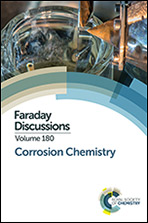Determination of the local corrosion rate of magnesium alloys using a shear force mounted scanning microcapillary method†
Abstract
The successful development of scanning probe techniques to characterize corrosion in situ using multifunctional probes is intrinsically tied to surface topography signal decoupling from the measured electrochemical fluxes. One viable strategy is the shear force controlled scanning microcapillary method. Using this method, pulled quartz micropipettes with an aperture of 500 nm diameter were used to resolve small and large variations in topography in order to quantify the local corrosion rate of microgalvanically and galvanically corroded Mg alloys. To achieve topography monitoring of corroded surfaces, shear force feedback was employed to position the micropipette at a reproducible working height above the substrate. We present proof of concept measurements over a galvanic couple of a magnesium alloy (AE44) and mild steel along with a microgalvanically corroded ZEK100 Mg alloy, which illustrates the ability of shear force to track small (1.4 μm) and large (700 μm) topographic variations from high aspect ratio features. Furthermore, we demonstrate the robustness of the technique by acquiring topographic data for 4 mm along the magnesium–steel galvanic couple sample and a 250 × 30 μm topography map over the ZEK100 Mg alloy. All topography results were benchmarked using standard optical microscopies (profilometry and confocal laser scanning microscopy).
- This article is part of the themed collection: Corrosion Chemistry

 Please wait while we load your content...
Please wait while we load your content...